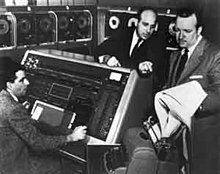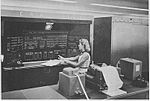Remington Edge

Remington Rand (1927-1955) was an American computer manufacturers, whose most tester computer UNIVAC I was. Remington Rand was formed in 1927 out of the Remington Typewriter Company , the Rand Kardex Company , and the Powers Accounting Machine Company . In 1950, Remington Rand bought Eckert-Mauchly Computer Corporation , which the two developers of ENIAC had founded in 1946. In 1951 the first UNIVAC I was delivered to the US Federal Statistical Office . Remington Rand merged with the Sperry Corporation to form Sperry Rand (later just Sperry ) in 1955 . Sperry and Burroughs Corporation formed Unisys in 1986 .
Remington Rand also produced tabs , electric razors , typewriters (Remington), filing cabinets (Kardex).
history
In 1865 Remington Arms became a public company and began a new line of business in 1873 - typewriter production . This branch was sold to the Standard Typewriter Company in 1886 , including the rights to use the name Remington . In 1902 the Standard Typewriter Company was renamed the Remington Typewriter Company . In 1927 the Remington Typewriter Company merged with Rand Kardex Company and Powers Accounting Machine Company under the new name "Remington Rand". Remington Rand continued to manufacture typewriters and became one of the largest computer manufacturers ( UNIVAC ) of its time.
- 1950 Acquisition of Eckert-Mauchly Computer Corporation - (EMCC)
- 1952 Acquisition of Engineering Research Associates - (ERA)
- 1955 Merger with Sperry Corporation to become Sperry Rand
Remington typewriters
The Remington typewriters were the first mass-produced typewriters, which were brought onto the market in 1874, then by Remington Arms , with a QWERTY keyboard. Christopher Latham Sholes , who developed a typewriter with a QWERTY keyboard, tried to sell his Western Union development for $ 50,000, but failed. An exclusive contract for the manufacture of the typewriters was then concluded with Remington Arms . The Remington No. 1 was not yet able to switch between upper and lower case letters. The type levers hit the roller on which the paper was guided from below. At the time of typing, it was therefore not possible to see what was being written. The writing only appeared about 5 lines later. The Remington No. 2 appeared in 1878 and could be switched between uppercase and lowercase letters and transport the ribbon independently. In the early days of the typewriter, the Remington system dominated with the keystroke from the bottom of the platen. The later common design with the stop from the front was brought onto the market by the Underwood company . The design with Wagner gear was also adopted by Remington after 1900. After the breakthrough of this type of typewriter, the typewriter became widespread. The standard model was built by many manufacturers. Exotic stop variants have been pushed out of the market. Well-known manufacturers in Germany were Mercedes, Naumann, Rheinmetall, Continental, Urania, Bing, Olympia, Adler, Triumph and many more.
A famous early user of Remington typewriters was Mark Twain .
The development of the Remington typewriter introduced a new industry. Since the typewriters allowed a higher typing speed than by hand, there were great increases in efficiency in office work. Not only economic aspects are to be considered, but also social and societal upheavals that were driven by the introduction of the typewriter.
This process can be demonstrated by statistics from stenographers and typists in the United States : while in 1870 there was still 4.5 percent women, this had already risen to 40 percent in 1880; After the industrial production of the typewriter in the factories of the arms manufacturer Remington Arms (model Remington II from 1881), this proportion rose to over 80 percent in 1910 and was finally 95.6 percent in 1930. Other indications of this character are the considerable acceleration of the speed of transcription made possible by the typewriter; this leads to the term "discourse machine gun".
The UNIVAC

After World War II, few people believed that computers had a future. The Eckert-Mauchly Computer Corporation ( EMCC ), founded in 1946 by J. Presper Eckert and John W. Mauchly , was one of the few companies that was convinced that electronic computing systems could be used universally , i.e. not only in science for specific calculations of complex ones mathematical problems can be used, but can also be used in business.
The Eckert-Mauchly Computer Corporation worked on the BINAC , a smaller version of the ENIAC , which was built for the Northrop Corporation . In 1948 EMCC was commissioned to build a computer for the US Census Bureau , which should be ready for the 1950 census. Due to financial difficulties, the appointment could not be kept and the Eckert-Mauchly Computer Corporation was taken over by Remington Rand on February 15, 1950. The EMCC was integrated into the Remington Rand organization as the UNIVAC business unit .
When UNIVAC I was handed over to the US Census Bureau in 1951 , it ushered in the era of commercial electronic computing systems, and for some years the name UNIVAC was used to represent all computers. This was the first time a computer manufactured for commercial purposes was used anywhere in the world.
UNIVAC became famous after the presidential election night in 1952. It was used to calculate an extrapolation based on 7% of the votes counted. As a result, the computer predicted a landslide victory for Eisenhower at 9 o'clock in the evening , in contradiction to conventionally calculated prognoses of a head-to-head race. The client did not trust the UNIVAC forecast and decided not to publish it. It was later found to be quite accurate: the predicted electoral distribution of 438 for Eisenhower and 93 for Stevenson came close to the actual distribution of 442: 89. UNIVAC made this result known worldwide.
The ERA
1952 Engineering Research Associates (ERA) was bought by Remington Rand. The ERA team was originally a group of scientists and engineers who worked for the US Navy during World War II , primarily in the field of cryptography . At the end of the war they founded the Engineering Research Associates, which mainly built computers in the field of cryptanalysis .
ERA focused on scientific and military computers while Eckert-Mauchly focused on civil computers ( UNIVAC ). But when Remington Rand merged with the Sperry Corporation in 1955 , the two business units were merged under the common name UNIVAC . The original computers ERA 1101, 1102 and 1103 were renamed UNIVAC 1101 , UNIVAC 1102 and UNIVAC 1103 .
literature
- James M. Utterback: Mastering the Dynamics of Innovation, ISBN 0-87584-740-4 .
- Arthur L. Norberg, Computers and Commerce: A Study of Technology and Management at Eckert-Mauchly Computer Company, Engineering Research Associates, and Remington Rand, 1946-1957 (History of Computing) (Hardcover), ISBN 0-262-14090-X
- James W. Cortada, Before the Computer: IBM, NCR, Burroughs, and Remington Rand and the Industry They Created, 1865-1956 (Studies in Business and Technology), ISBN 0-691-05045-7 .
- Unisys History Newsletter, Volume 4 Number 1, May 2000, Remington Rand Tabulating Machines by George Gray (English)

